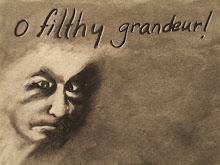Note: Though I do not give a full summary, please be aware that some of the discussions inevitably mean that there are spoilers. Also, I've broken up my essay so it's easier on the eyes. You can read the first two parts of my essay here and here.
Identity and Duality
In the novel, we are presented with several dualities, opposing labels or ideas that alter perceptions of identities. For instance, the Iron Councillors being “sisters” feminizes the runaway train. Conversely, there are two groups in New Crobuzon: the Toroans, and Runagate Rampant. Though the Toroans are active and violent (masculine) and Runagate Rampant, is passive (well, passive in the sense that they aren’t out riling up crowds and murdering political figures—they’re just publishing revolutionary ideas) Runagate Rampant does have some masculine attribute at least. The members are all referred to as “Jack,” in honor of Jack Half-a-Prayer—a Remade man uplifted as a symbol for freedom. The use of the moniker “Jack” masculinizes Runagate Rampant. That these groups are led by their respective sexes (Ann-Hari leading the Iron Council—although they are a Council, Ann-Hari’s daring persuasion means she gets what she wants, and is thus the leader) further illustrates the gendering of these groups—and further, how these groups are fluidly gendered: Toro later being revealed to be a woman, the titles used by the Council and Runagate, and Runagate being led first by a man named Curdin, until he is captured and sentenced to Remaking, and later is led by Madeleina. The use of the name “Jack” to refer to all members is supposed to protect their identities from militia intervention. Basically, even the groups are simultaneously something else.
There’s also this duality concerning the Remade and the “free and whole.” These identities are clearly defined, as “whole and Remade could not fraternize” in certain areas of the city (323), and in fact Remade are treated as slaves, especially by the TRT. Remade cannot be made whole again—they were created in the punishment factories, condemned to have their bodies refashioned, parts added or subtracted as retribution for some crime. It is only a one way journey, since Remade are made from whole, and the procedures are irreversible (or at least there are laws against reversibility).
The character of Toro presents us with interesting notions of identity. First, Toro is the leader of a violent revolutionary gang in New Crobuzon, but this identity shifts to another body when the Toroans execute a plot to kill Mayor Stem-Fulcher. When Toro removes her helmet, what ensues is a moment of disconnect—her real identity is revealed:
Something went out of the air as Toro pulled the helmet away and broke a thaumaturgic current. Toro lifted the metal off, like a diver removing the heavy brass helmet. Toro shook out her sweaty hair (392).
When Toro the Remade woman remains behind (and presumably dies) Ori must escape using the Toro-helmet to push through reality. His learning to use the helmet is his first moment of accepting the Toro identity (397). Ori, defeated at finding out he was used, uses the Toro identity. Toro “was a dog now, a stupid and brutalized dog following a master it hated, unable to stop” (454). This new “Ori, Toro” (454) identity is mostly explored in Chapter Twenty-Seven, where Ori, Toro travels through the seams in reality. Ori is just Ori during the day, only using the bull helmet “to walk at night, and he did not know why” (456).
The Toro identity is a tool, dependent on the user:
Toro could have been a fighter for the Collective. Toro could have stood on the barricades, run boulevards between bomb-denuded trees and gored militia.
Ori did not[…] He was deadened by failure (456).
Toro is a transferable identity, a symbol of revolution, action, change. Toro is a Remade woman’s mask, which she uses for her own agenda. Toro’s identity merges with Ori’s, at some points separate identities, at others, merged identities. Ori “would rise and, as Toro” would travel, hunting his enemy using the thaumaturgy in the helmet. Ori is defeated, and thus, so is Toro. Toro “stalked at night” while Ori remains “unseen in his bull-head” (457).
In the world that Miéville has created, everything is something else. There are different aspects of everyone, everything may not be as it seems, and like in real life the reader has no way to guess how the story will turn out (unlike an Eddings’ novel where we know the good guy always wins—take that!). Even the crazy old man, Spiral Jacobs, isn’t just a crazy old man: “Spiral Jacobs was drunk. He was a real vagrant. He was just something else as well” (458). Even his “freedom spirals” (430) are simultaneously symbols for freedom, but later revealed to be the city’s doom if Spiral Jacobs is not stopped—in his madness, the old man wanders the city tracing spirals on buildings in preparation to unleash a hex that would destroy the whole city (and the interesting thing, if you’re familiar with Miéville’s work, is that you believe that the city could be destroyed. We have no reason to trust the narrator, or to trust that any plan will be successful—this is real; plans and people fail, and Miéville captures this perfectly).
Conclusion
Iron Council presents certain ideas of gender and sexuality, identity, duality, and a sense of realness. There is greatness in this sort of writing which combats the usual fantasy formula of good vs. evil, and the process of good always triumphing. The realness in Miéville’s novels and his excellent mastery of language makes his works incomparable. That being said, I am counting down until The City and the City is released.


0 comments:
Post a Comment